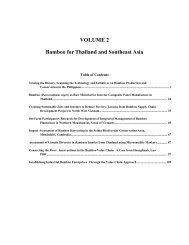WBC-VIII-Vol.4 – Resources – Forestry, Plantations and ... - BambuSC
WBC-VIII-Vol.4 – Resources – Forestry, Plantations and ... - BambuSC
WBC-VIII-Vol.4 – Resources – Forestry, Plantations and ... - BambuSC
You also want an ePaper? Increase the reach of your titles
YUMPU automatically turns print PDFs into web optimized ePapers that Google loves.
altitude but has excellent growing conditions <strong>and</strong> high rainfall. Y. alpina was not analyzed in this study, but it is<br />
should be planted in Olenguruone <strong>and</strong> at high altitude areas where it can thrive.<br />
The overall performance ranking is based on an analysis of the various criteria of each species shown in Table<br />
18 to Table 30. The analysis of the Muguga trial site shows the following results.<br />
Species<br />
Rank<br />
Table 26: Species to Site Matching for Muguga<br />
Overall<br />
Performance<br />
Ranking Criteria<br />
Site Observation Analysis Benchmark Comparative Analysis<br />
Potential Yield<br />
(EY)<br />
Culms per Clump<br />
(AC)<br />
Culm Weight<br />
(DM %)<br />
Culm Height<br />
(H %)<br />
1 T. siamensis D. br<strong>and</strong>isii D. hamiltonii T. siamensis T. siamensis<br />
2 D. hamiltonii D. hamiltonii B. vulgaris B. vulgaris C. pergracile<br />
3 B. vulgaris B. vulgaris T. siamensis D. br<strong>and</strong>isii D. strictus<br />
4 D. br<strong>and</strong>isii D. strictus D. br<strong>and</strong>isii D. hamiltonii B. vulgaris<br />
5 D. strictus B. tulda D. strictus D. strictus D. hamiltonii<br />
6 B. tulda C. pergracile B. tulda C. pergracile D. br<strong>and</strong>isii<br />
7 D. membranaceus T. siamensis D. membranaceus B. tulda B. tulda<br />
8 C. pergracile D. membranaceus C. pergracile D. membranaceus D. membranaceus<br />
In terms of its benchmark performance, T. siamensis is one of the species that did well in Muguga. In the trials<br />
it was planted in intervals of 5m x 5m but, as mentioned earlier, more proximate planting distances can be used<br />
to maximize its yield per hectare.<br />
D. hamiltonii showed good performance in terms of the number of culms per clump as well as in potential yield.<br />
Vigorous shoot growth was observed in the trial in Muguga. Although it ranks second to T. siamensis, it should<br />
be regarded as a priority species for the production of large culms.<br />
B. vulgaris produces a high number of culms per clump. It showed a very good relative performance in terms of<br />
average culm weight <strong>and</strong> a high estimated potential yield per hectare.<br />
The potential yield of D. br<strong>and</strong>isii was the highest of the species planted in Muguga, but its relative performance<br />
in terms of height was low. As mentioned earlier in this report, there was some confusion in the Muguga site<br />
regarding species identification. D. asper does not appear in the above table but it was possibly mixed up with<br />
D. br<strong>and</strong>isii. The reasonably good performance of D. asper in Gigiri, Nairobi makes it a species to be<br />
considered in areas with similar conditions.<br />
It was observed that B. vulgaris grows well in Olenguruone <strong>and</strong> therefore this species should be one of the main<br />
species in plantations in that area. Other tropical species may not grow as well due to the cool climate, but they<br />
should nevertheless be tested. The species that perform poorly in the highl<strong>and</strong>s are B. bambos, followed by D.<br />
strictus <strong>and</strong> B. tulda. These species grow more favorably in warmer conditions.<br />
<strong>VIII</strong> World Bamboo Congress Proceedings Vol 4-136




